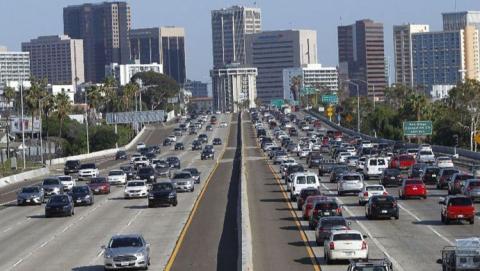
Publisher
Some people got so upset about a proposed “road user charge” that they didn’t even take a minute to think through the numbers that may prove the concept is actually more fair to drivers, especially lower income families, than it may appear at first blush.
The local proposal was floated at a recent meeting of SANDAG, the San Diego Association of Governments, our local planning agency that collects and spends tax money for regional transportation projects.
The state already has a pilot program tracking about 5,000 vehicles to see how charging drivers based on the miles they drive could be implemented on a statewide basis.
The state is proposing a 2-cent per mile charge, and SANDAG suggested an additional 2-cent charge to fund local projects in its recent draft regional transportation plan.
Full implementation of the state program has been pushed back to 2027 and SANDAG leaders say the launch of their proposal would most likely coincide with the state’s program.
Proponents argue that revenues from per-gallon taxes are going down as more people switch to electric vehicles, which will only get worse because California has mandated that, by 2035, all cars sold in the state must be zero-emission vehicles that will not use any gasoline.
Critics say that tracking and charging drivers may be difficult by using transponders, annual mileage checks, or other mechanisms.
Public opposition was quick to develop, and San Diego Mayor Todd Gloria, also currently the Chairman of SANDAG’s board, along with the Mayors of National City and Encinitas, already came out against the idea to appease concerned voters who are outraged at the thought of paying per mile they drive.
Although the idea may sound shocking at first, looking at the bigger picture shows some advantages over the current gas tax scheme that penalizes lower income drivers in direct and indirect ways.
First, the total charges on a per-mile basis are not as high as some may think.
Four cents per mile, for the average of 12,000 miles driven per year, would be $480 in road user charges per year. Obviously, if you drive more miles or fewer miles your overall tax would change.
For comparison, under the current system, we pay a combined $1.18 in taxes and fees on each gallon of gasoline, including Federal Excise Taxes of 18 cents, a State Excise Tax of 51 cents, Sales Taxes of about 10 cents, a Low Carbon Gas Programs fee of 22 cents, Greenhouse Gas Programs fees of 15 cents, and an Underground Tank Storage fee of 2 cents. On an average fill-up of 22 gallons, that’s almost $26 just in taxes and fees.
So, someone who drives the same 12,000 miles per year and their car fuel economy is the national average of 24.9 miles per gallon currently pays $568.67 in gas taxes and fees, or $88.67 more per year than if they paid the $.04 per mile usage tax.
But, here is where the disparate impact of the per-gallon taxes begin to show how regressive the current scheme really is toward lower income drivers.
What if a lower income working family has an older car that is not as fuel-efficient as a newer car?
If their older car only averages 21 miles per gallon, their total gas taxes would be $674.28, or $194.28 more per year than the 4-cents per mile tax, even though they drove the same amount of miles.
Or, if their older car only averages 19 miles per gallon, which is the combined fuel economy rating for 15-year-old Toyota minivan, their taxes would go up to $745.26, or $265.26 higher than than the proposed $.04 per mile tax.
As new cars get more expensive, lower income families hold on to their cars longer or buy older used cars which are cheaper, but much less fuel efficient, than new cars.
New statistics show that the average age of light vehicles in the US increased to over 12-years old during the past year as the economic effects of the COVID pandemic pushed new cars sales to historic lows. Of course, those impacts of job losses fell disproportionate on lower-income hourly workers who could least afford the losses.
Cars.com reports that the average age of cars in the US is now 12.1 years old, compare to only 10.9 years old in 2011, 8.9 years old in 2001, 5.5 years old in 1977, and only 5.1 years old back in 1969.
So the older a car is, the lower the fuel efficiency and, therefore, the more gallons of gas used for the same miles traveled compared to a newer car. More gallons per mile means more taxes per year.
SANDAG’s proposal acknowledges the concerns of how to track and charge for a possible per-mile tax, and also offered an alternative way to tax drivers to encourage them to buy new cars; raise fees on less-efficient vehicles.
Again, that’s just another regressive tax to punish lower income families who can least afford to upgrade to newer, more efficient cars and electric vehicles, which are even more expensive than gas cars.
Likewise, tax credits on zero-emission vehicles may incentivize high-earners to save on their taxes, but most working poor and lower income families cannot use the tax credits because they don’t earn enough to owe enough personal income taxes.
We all agree that the move toward zero-emission vehicles is coming, and revenues from gas taxes will continue to shrink until they’re gone forever.
A per-mile tax scheme is a more equitable way to charge drivers for the roads and highways they use, and to charge more to those who drive more. That’s all fair.
But charging disproportionately more in gas taxes to those who already can’t afford to upgrade to more efficient or zero-emission cars is regressive and counter-productive.
Climate change is affecting us all, but our most vulnerable working families are the least able to spend more on new cars to help reduce carbon emissions, and continuing to charge them more in gas taxes will only make it harder for them to get to work and feed their families.
SANDAG and our State Legislature must look for more fair ways to tax drivers as we move toward a more sustainable future, together.
Castañares is the Publisher and Editor-at-Large of La Prensa San Diego. He is the 2021 winner of the Ruben Salazar National Journalism Award for Print Journalism presented by the California Chicano News Media Association. He can be reached at art@laprensasd.com.
